The British Industrial Revolution 英国工业革命
- 格式:ppt
- 大小:3.26 MB
- 文档页数:25



英国工业革命:历史上科技与工业进步的里程碑The Industrial Revolution in Britain: Milestones in Technological and Industrial ProgressThe Industrial Revolution, which occurred from the 18th to the19th century, was a pivotal moment in human history. It marked a significant shift from traditional handmade methods to machine production and ushered in an era of technological advancements that would shape the modern world. The revolution began in Britain and can be attributed to several key milestones that propelled the country to the forefront of industrialization.One of the earliest milestones in the Industrial Revolution was the invention of the spinning jenny by James Hargreaves in 1764. This simple yet ingenious device allowed one person to spin multiple threads simultaneously, greatly increasing the efficiency of textile production. This innovation laid the foundation for the mechanization of the textile industry and initiated a wave of further inventions and improvements in manufacturing processes. Another milestone in this period was the invention of the steam engine by James Watt in 1776. Watt's steam engine was more efficient and versatile than its predecessors, and it became a key factor in powering the industrial machinery of the time. The steam engine revolutionized transportation, enabling the development of railways, steamships, and factories. It also marked a transition from using traditional sources of energy, such as water and wind, to harnessing the power of steam, which could be applied in various industries.The development of the factory system was another significant milestone during the Industrial Revolution. Prior to this period, production was primarily done in small workshops or homes. However, with advancements in machinery and the need for large-scale production, centralized factories became more prevalent. Factory workers, often including women and children, labored long hours in cramped conditions. This new system allowed for mass production on a previously unimaginable scale, leading to increased productivity and economic growth.The introduction of the spinning mule by Samuel Crompton in 1779 was yet another milestone in the textile industry. The spinning mule combined the best features of the spinning jenny and the water frame, producing strong and fine yarns. This innovation further propelled the textile industry, making Britain the world leader in textiles and prompted rapid urbanization around factory towns.In addition to advancements in manufacturing, the Industrial Revolution also saw improvements in transportation and communication. The construction of canals and later, the development of railways, significantly reduced transportation costs and improved connectivity between regions. This facilitated the movement of goods and people, stimulating trade and opening up new markets. The invention of the telegraph in the 1830s further revolutionized communication, allowing for almost instantaneous long-distance communication for the first time in human history. The Industrial Revolution had profound social and economic impacts. It led to the growth of cities, population expansion, andthe rise of the working class. The living conditions for many workers were harsh, with overcrowding, pollution, and poor sanitation. However, this period also saw the emergence of labor movements and the fight for workers' rights, leading to improvements in working conditions and labor laws.In conclusion, the Industrial Revolution in Britain was marked by several key milestones that propelled the country to the forefront of industrialization. The inventions of the spinning jenny, steam engine, spinning mule, and the development of the factory system revolutionized manufacturing processes and unleashed the potential of mass production. The advancements in transportation and communication further fueled economic growth and connectivity. Although the process was not without its hardships, the Industrial Revolution laid the foundation for the modern world and set the stage for further technological advancements that would shape human society as we know it today.The Industrial Revolution in Britain: Economic and Social TransformationsThe Industrial Revolution in Britain brought about significant economic and social transformations, creating a new era of productivity and prosperity. As the country underwent rapid industrialization, it experienced the emergence of new industries, changes in the workforce, urbanization, and advancements in living conditions. These developments were not without their challenges, but they laid the groundwork for the modern world we live in today.One of the primary effects of the Industrial Revolution was the growth and diversification of industries. The mechanization oftextile production, made possible by inventions such as the spinning jenny and spinning mule, transformed the textile industry into a major economic force. It propelled the country to become the world leader in textiles, leading to increased exports and wealth generation. Additionally, other industries such as iron and coal mining, pottery, and transportation also experienced significant growth during this period.With the rise of factories and the need for skilled workers, there was a shift in the workforce composition. Small workshops and cottage industries could not keep up with the demands of mass production, leading to the migration of workers from rural areas to urban centers. The rural to urban migration created a surplus of labor, which resulted in lower wages and exploitation. Many workers, including women and children, endured harsh working conditions and long hours to sustain themselves and their families.The urbanization caused by the Industrial Revolution led to the rapid growth of cities and the creation of factory towns. Cities such as Manchester, Birmingham, and Leeds witnessed a population explosion as people flocked to urban centers in search of employment opportunities. However, this rapid urbanization was accompanied by overcrowding and insufficient infrastructure. Many workers and their families lived in slums, characterized by poor housing, inadequate sanitation, and high levels of pollution. These adverse living conditions contributed to the spread of diseases and social problems.The emergence of factories and the factory system brought about significant changes in the organization of work. In the pre-industrial era, skilled craftsmen produced goods in small workshops or at home. However, the factory system concentrated production in centralized locations, employing unskilled workers who performed repetitive tasks. This shift from skilled craftsmanship to mass production marked a fundamental change in the nature of work.The advancements in transportation played a crucial role in fueling the Industrial Revolution and facilitating economic growth. The construction of canals, such as the Bridgewater Canal, and the development of the railway network greatly reduced transportation costs and increased the ease of moving goods and raw materials. This resulted in improved connectivity between regions, stimulated trade both domestically and internationally, and opened up new markets for British goods.The Industrial Revolution also had profound social implications. The harsh working conditions and low wages led to the emergence of labor movements and the fight for workers' rights. Workers began organizing and advocating for improved working conditions, higher pay, and shorter working hours. Gradually, labor laws were implemented to protect workers and regulate labor practices. These movements paved the way for the establishment of trade unions and the creation of rights and benefits for workers that are still enjoyed today.Furthermore, the Industrial Revolution brought about a fundamental shift in society. It accelerated the process of urbanization and led to the growth of a new working class, comprised of individuals who depended on factory work for theirlivelihood. The industrial working class became distinct from the rural agricultural society that existed before, leading to new social dynamics and the rise of class consciousness.In conclusion, the Industrial Revolution in Britain had far-reaching economic and social consequences. It fueled the growth of new industries, transformed the composition of the workforce, urbanized the country, and improved transportation infrastructure. However, these changes also brought about challenges such as poor living conditions, exploitation of workers, and social inequality. Nevertheless, the Industrial Revolution laid the foundation for the modern industrial society and set the stage for further technological advancements and social progress.。
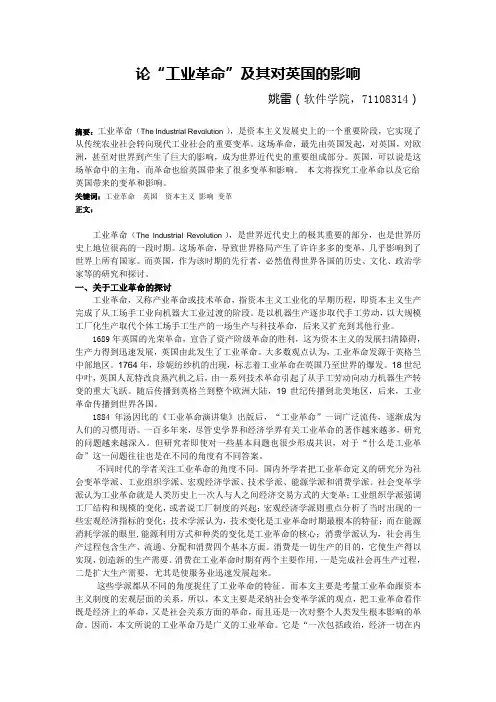
论“工业革命”及其对英国的影响姚雷(软件学院,71108314)摘要:工业革命(The Industrial Revolution ),是资本主义发展史上的一个重要阶段,它实现了从传统农业社会转向现代工业社会的重要变革。
这场革命,最先由英国发起,对英国,对欧洲,甚至对世界到产生了巨大的影响,成为世界近代史的重要组成部分。
英国,可以说是这场革命中的主角,而革命也给英国带来了很多变革和影响。
本文将探究工业革命以及它给英国带来的变革和影响。
关键词:工业革命英国资本主义影响变革正文:工业革命(The Industrial Revolution ),是世界近代史上的极其重要的部分,也是世界历史上地位很高的一段时期。
这场革命,导致世界格局产生了许许多多的变革,几乎影响到了世界上所有国家。
而英国,作为该时期的先行者,必然值得世界各国的历史、文化、政治学家等的研究和探讨。
一、关于工业革命的探讨工业革命,又称产业革命或技术革命,指资本主义工业化的早期历程,即资本主义生产完成了从工场手工业向机器大工业过渡的阶段。
是以机器生产逐步取代手工劳动,以大规模工厂化生产取代个体工场手工生产的一场生产与科技革命,后来又扩充到其他行业。
1689年英国的光荣革命,宣告了资产阶级革命的胜利,这为资本主义的发展扫清障碍,生产力得到迅速发展,英国由此发生了工业革命。
大多数观点认为,工业革命发源于英格兰中部地区。
1764年,珍妮纺纱机的出现,标志着工业革命在英国乃至世界的爆发。
18世纪中叶,英国人瓦特改良蒸汽机之后,由一系列技术革命引起了从手工劳动向动力机器生产转变的重大飞跃。
随后传播到英格兰到整个欧洲大陆,19世纪传播到北美地区,后来,工业革命传播到世界各国。
1884年汤因比的《工业革命演讲集》出版后,“工业革命”一词广泛流传,逐渐成为人们的习惯用语。
一百多年来,尽管史学界和经济学界有关工业革命的著作越来越多,研究的问题越来越深入。
但研究者即使对一些基本问题也很少形成共识,对于“什么是工业革命”这一问题往往也是在不同的角度有不同答案。

The Industrial Revolution (1780-1830)1.The industrial Revolution refers to the mechanization of industry and the consequent changes in social and economic organization in Britain in the late 18th and early 19th centuries.2.Britain was the first country to industrialize because of the following factors:(1)Favorable geographical location. Britain was well placed geographically to participate in European and world trade;(2)Political stability. Britain had a peaceful society, which, after the 17th century, was increasingly interested in overseas trade and colonies. International trade brought wealth to merchants and city bankers. They and those who had done well out of new farming methods provided capital in large quantities for industrialization. (3) Good foundation in economy. The limited monarchy which resulted from the Glorious Revolution of 1688 ensured that the powerful economic interests in the community could exert their influence over Government policy.(4) It was a country in which the main towns were never too far from seaports, or from rivers, which could distribute their product(5) Britain had many rivers, which were useful for transport but also for water and steam power. Britain also had useful mineral resources. (6) British engineers had sound training as craftsmen.(7) The inventors were respected. They solved practical problems.(8) Probably laissez faire and “Protestant work ethic” helped.(9) England, Scotland, and Wales formed a customs union after 1707 and this included Ireland after 1807. So the national market was not hindered by internal customs barriers.(10) The enclosures and other improvements in agriculture made their contributions by providing food for the rising population, labour for the factories, and some of the raw materials needed by industry。

论“工业革命”及其对英国的影响姚雷(软件学院,71108314)摘要:工业革命(The Industrial Revolution ),是资本主义发展史上的一个重要阶段,它实现了从传统农业社会转向现代工业社会的重要变革。
这场革命,最先由英国发起,对英国,对欧洲,甚至对世界到产生了巨大的影响,成为世界近代史的重要组成部分。
英国,可以说是这场革命中的主角,而革命也给英国带来了很多变革和影响。
本文将探究工业革命以及它给英国带来的变革和影响。
关键词:工业革命英国资本主义影响变革正文:工业革命(The Industrial Revolution ),是世界近代史上的极其重要的部分,也是世界历史上地位很高的一段时期。
这场革命,导致世界格局产生了许许多多的变革,几乎影响到了世界上所有国家。
而英国,作为该时期的先行者,必然值得世界各国的历史、文化、政治学家等的研究和探讨。
一、关于工业革命的探讨工业革命,又称产业革命或技术革命,指资本主义工业化的早期历程,即资本主义生产完成了从工场手工业向机器大工业过渡的阶段。
是以机器生产逐步取代手工劳动,以大规模工厂化生产取代个体工场手工生产的一场生产与科技革命,后来又扩充到其他行业。
1689年英国的光荣革命,宣告了资产阶级革命的胜利,这为资本主义的发展扫清障碍,生产力得到迅速发展,英国由此发生了工业革命。
大多数观点认为,工业革命发源于英格兰中部地区。
1764年,珍妮纺纱机的出现,标志着工业革命在英国乃至世界的爆发。
18世纪中叶,英国人瓦特改良蒸汽机之后,由一系列技术革命引起了从手工劳动向动力机器生产转变的重大飞跃。
随后传播到英格兰到整个欧洲大陆,19世纪传播到北美地区,后来,工业革命传播到世界各国。
1884年汤因比的《工业革命演讲集》出版后,“工业革命”一词广泛流传,逐渐成为人们的习惯用语。
一百多年来,尽管史学界和经济学界有关工业革命的著作越来越多,研究的问题越来越深入。
但研究者即使对一些基本问题也很少形成共识,对于“什么是工业革命”这一问题往往也是在不同的角度有不同答案。
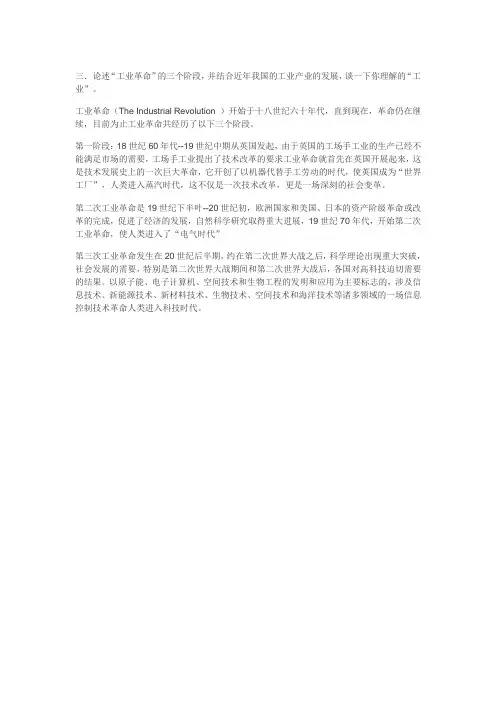
三.论述“工业革命”的三个阶段,并结合近年我国的工业产业的发展,谈一下你理解的“工业”。
工业革命(The Industrial Revolution )开始于十八世纪六十年代,直到现在,革命仍在继续,目前为止工业革命共经历了以下三个阶段。
第一阶段:18世纪60年代--19世纪中期从英国发起,由于英国的工场手工业的生产已经不能满足市场的需要,工场手工业提出了技术改革的要求工业革命就首先在英国开展起来,这是技术发展史上的一次巨大革命,它开创了以机器代替手工劳动的时代,使英国成为“世界工厂”,人类进入蒸汽时代,这不仅是一次技术改革,更是一场深刻的社会变革。
第二次工业革命是19世纪下半叶--20世纪初,欧洲国家和美国、日本的资产阶级革命或改革的完成,促进了经济的发展,自然科学研究取得重大进展,19世纪70年代,开始第二次工业革命,使人类进入了“电气时代”
第三次工业革命发生在20世纪后半期,约在第二次世界大战之后,科学理论出现重大突破,社会发展的需要,特别是第二次世界大战期间和第二次世界大战后,各国对高科技迫切需要的结果。
以原子能、电子计算机、空间技术和生物工程的发明和应用为主要标志的,涉及信息技术、新能源技术、新材料技术、生物技术、空间技术和海洋技术等诸多领域的一场信息控制技术革命人类进入科技时代。
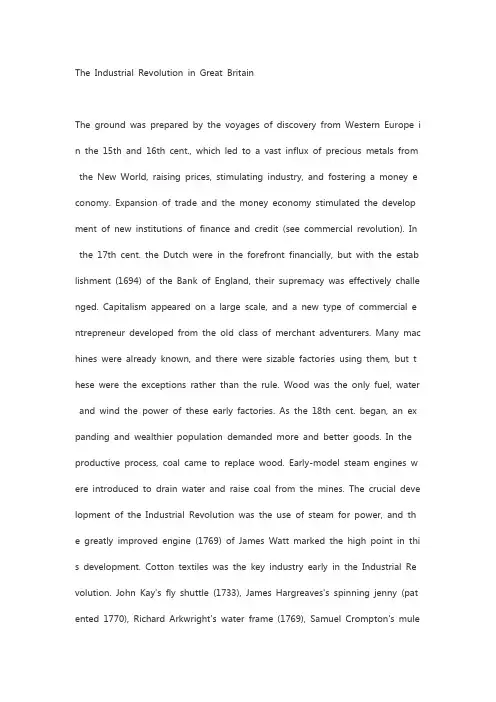
The Industrial Revolution in Great BritainThe ground was prepared by the voyages of discovery from Western Europe in the 15th a nd 16th cent., which led to a vast influx of precious metals from the New World, raising prices, stimulating industry, and fostering a money economy. Expansion of trade and the money economy stimulated the development of new institutions of finance and credit (see commercial revolution). In the 17th cent. the Dutch were in the forefront financially, but with the establishment (1694) of the Bank of England, their supremacy was effectively ch allenged. Capitalism appeared on a large scale, and a new type of commercial entrepreneu r developed from the old class of merchant adventurers. Many machines were already kno wn, and there were sizable factories using them, but these were the exceptions rather than the rule. Wood was the only fuel, water and wind the power of these early factories. As the 18th cent. began, an expanding and wealthier population demanded more and better g oods. In the productive process, coal came to replace wood. Early-model steam engines w ere introduced to drain water and raise coal from the mines. The crucial development of t he Industrial Revolution was the use of steam for power, and the greatly improved engine (1769) of James Watt marked the high point in this development. Cotton textiles was the key industry early in the Industrial Revolution. John Kay's fly shuttle (1733), James Harg reaves's spinning jenny (patented 1770), Richard Arkwright's water frame (1769), Samuel Crompton's mule (1779), which combined the features of the jenny and the frame, and Ed mund Cartwright's power loom (patented 1783) facilitated a tremendous increase in output. The presence of large quantities of coal and iron in close proximity in Britain was a dec isive factor in its rapid industrial growth. The use of coke in iron production had far-reac hing effects. The coal mines from the early 1700s had become paramount in importance, and the Black Country appeared in England at the same time that Lancashire and Yorkshi re were being transformed into the greatest textile centers of the world. Factories and indu strial towns sprang up. Canals and roads were built, and the advent of the railroad and th e steamship widened the market for manufactured goods. The Bessemer process made a gi gantic contribution, for it was largely responsible for the extension of the use of steam an d steel that were the two chief features of industry in the middle of the 19th cent. Chemi cal innovations and, most important of all, perhaps, machines for making machines played an important part in the vast changes. The Industrial Revolution did not in fact end in B ritain in the mid-1800s. New periods came in with electricity and the gasoline engine. By1850, however, the transformation wrought by the revolution was accomplished, in that i ndustry had become a dominant factor in the nation's life.。
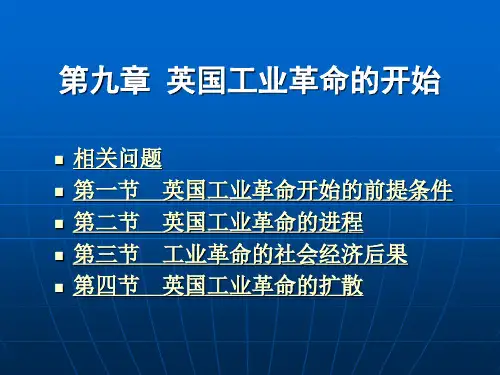
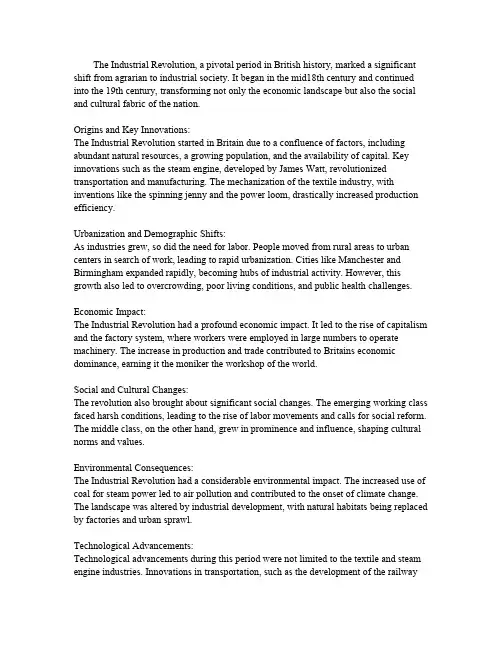
The Industrial Revolution,a pivotal period in British history,marked a significant shift from agrarian to industrial society.It began in the mid18th century and continued into the19th century,transforming not only the economic landscape but also the social and cultural fabric of the nation.Origins and Key Innovations:The Industrial Revolution started in Britain due to a confluence of factors,including abundant natural resources,a growing population,and the availability of capital.Key innovations such as the steam engine,developed by James Watt,revolutionized transportation and manufacturing.The mechanization of the textile industry,with inventions like the spinning jenny and the power loom,drastically increased production efficiency.Urbanization and Demographic Shifts:As industries grew,so did the need for labor.People moved from rural areas to urban centers in search of work,leading to rapid urbanization.Cities like Manchester and Birmingham expanded rapidly,becoming hubs of industrial activity.However,this growth also led to overcrowding,poor living conditions,and public health challenges. Economic Impact:The Industrial Revolution had a profound economic impact.It led to the rise of capitalism and the factory system,where workers were employed in large numbers to operate machinery.The increase in production and trade contributed to Britains economic dominance,earning it the moniker the workshop of the world.Social and Cultural Changes:The revolution also brought about significant social changes.The emerging working class faced harsh conditions,leading to the rise of labor movements and calls for social reform. The middle class,on the other hand,grew in prominence and influence,shaping cultural norms and values.Environmental Consequences:The Industrial Revolution had a considerable environmental impact.The increased use of coal for steam power led to air pollution and contributed to the onset of climate change. The landscape was altered by industrial development,with natural habitats being replaced by factories and urban sprawl.Technological Advancements:Technological advancements during this period were not limited to the textile and steam engine industries.Innovations in transportation,such as the development of the railwaysystem,facilitated the movement of goods and people,further integrating the national economy.Cultural Expression:The Industrial Revolution also influenced cultural expression.The Romantic movement, for instance,was partly a reaction to the industrialization,with poets and artists celebrating nature and rural life in contrast to the mechanized urban world. Legacy:The legacy of the Industrial Revolution is still felt today.It set the stage for modern industrial economies and continues to influence patterns of work,urban development, and global trade.The period also serves as a reminder of the need to balance industrial progress with social welfare and environmental sustainability.In conclusion,the British Industrial Revolution was a complex and transformative period that reshaped the nation and laid the groundwork for the modern world.Its effects were multifaceted,touching every aspect of society and leaving a lasting impact on the global stage.。
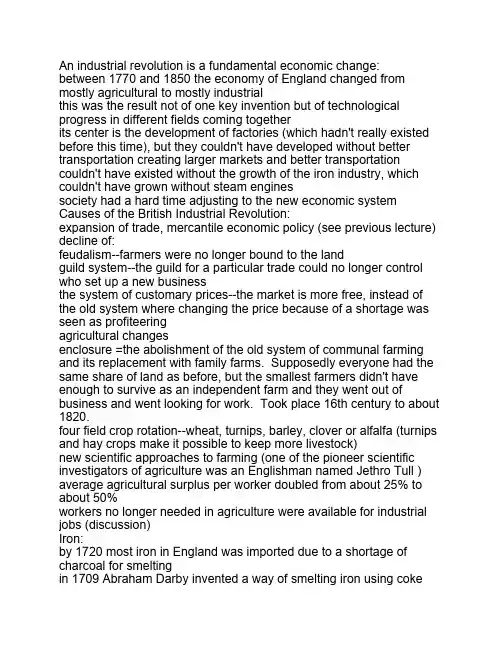
An industrial revolution is a fundamental economic change:between 1770 and 1850 the economy of England changed from mostly agricultural to mostly industrialthis was the result not of one key invention but of technological progress in different fields coming togetherits center is the development of factories (which hadn't really existed before this time), but they couldn't have developed without better transportation creating larger markets and better transportation couldn't have existed without the growth of the iron industry, which couldn't have grown without steam enginessociety had a hard time adjusting to the new economic system Causes of the British Industrial Revolution:expansion of trade, mercantile economic policy (see previous lecture) decline of:feudalism--farmers were no longer bound to the landguild system--the guild for a particular trade could no longer control who set up a new businessthe system of customary prices--the market is more free, instead of the old system where changing the price because of a shortage was seen as profiteeringagricultural changesenclosure =the abolishment of the old system of communal farming and its replacement with family farms. Supposedly everyone had the same share of land as before, but the smallest farmers didn't have enough to survive as an independent farm and they went out of business and went looking for work. Took place 16th century to about 1820.four field crop rotation--wheat, turnips, barley, clover or alfalfa (turnips and hay crops make it possible to keep more livestock)new scientific approaches to farming (one of the pioneer scientific investigators of agriculture was an Englishman named Jethro Tull ) average agricultural surplus per worker doubled from about 25% to about 50%workers no longer needed in agriculture were available for industrial jobs (discussion)Iron:by 1720 most iron in England was imported due to a shortage of charcoal for smeltingin 1709 Abraham Darby invented a way of smelting iron using coke(processed coal) instead of charcoalthe iron industry took off after 1760 since iron ore and coal were both very plentiful in England1779 Iron Bridge ( photo )The Steam Engine:Newcomen Engine (about 1712) filled a cylinder with steam and then condensed it to draw the piston down. 1/2% efficient, but widely used to pump water out of coal mines.Watt Engine (1774) had had a separate condenser, making the engine much more efficientJames Watt later added:sun and planet gear converted reciprocating into rotary motion to power machinesautomatic control mechanismdouble-acting engine made for much smoother power Transportation Technology:improved roads built in large numbers 1750-1815 (about 1000 miles), reduced transportation costs 20-30%CanalsThe Duke of Bridgewater's Canal started in 1759--7 miles but had to cross a river valley. People thought this was a wild dream, but built in 5 years. Very profitable--halved the cost of coal in Manchestercanal building boom 1750-1800--by 1830 England had 3875 miles of navigable water (though only 1/3 of that was canals). The Oxford canal paid a 30% return for 30 years.provided much cheaper transportation of bulky goodsThe Factory System:the first big industry was cotton textile factories, though other kinds of factories developed as wellmachines had been used some by workers who did piece work at home with spinning wheels and hand looms. What brought the workers together into a factory was the invention of machines for spinning that could spin more than one thread at a time and then the application of water power first to spinning and then to weaving James Hargreaves, Spinning Jenny , invented 1764-1770Roger Arkwright, Water Frame , 1769Samuel Crompton, Mule , 1774-1779Edmund Cartwright, Power Loom, 1786-1788With these technologies the industry took off--by 1833 237,000 peoplewere employed in cotton textile factories in Englandthis was a whole new way of life46% of workers were women, 15% children under the age of 13 ( Child Labor )wages were barely enough for a family to survive if all members over the age of 8 workedin some areas 1/2 to 3/4 of worker families lived in a single room with no plumbing (dumped their chamber pot into the street or gutter)for examples see Living and Working Conditions in the Industrial Revolutionreform laws started in 1833-- factory act of 1833 forbade employment of children under 9 and limited hours for children to 9 hours a day for children 9-13 and 12 hours a day for children 13-18Chartist movement fought unsuccessfully for political change, but conditions gradually improved中英对照供参考:工业革命指从农业和手工业经济转变到以工业和机器生产为主的变化过程。
基础英语国贸专业英汉互译题目总汇(7)国内工业 home industries国内产品 home products国内贸易 the home trade国内市场 the home market美国国会 the United States Congress外贸保税区法 the Foreign Trade Zones Act(英国)议院的法案 An Act of Parliament(美国)国会的法案 The Acts of congress外贸保税区管理委员会 the Foreign Trade Zone Board董事会 the Board of Directors国际商务局 the Bureau of International Commerce天津商检局 Tianjin Commodity Inspection Bureau美国商业部United States Department of Commerce市场经济 market economy计划经济 planned economy决定性的测验 the crucial test决定性的问题 the crucial question在重要的关头 at the crucial moment以分散的方式 in a decentralized fashion市场价格机制 a price-and-market mechanism技术工 skilled labor劳工与雇主之间的关系 labor relations工党 the Labor Party纯粹的形式 a pure form英国工业革命 the English Industrial Revolution 法国大革命 The French Revolution普遍地 at large倾向于做某事 be inclined to do sth.全社会 society at large有…倾向的 be subject to由…产生的 stem from实质上,根本上 in effect供求机制 the supply and demand mechanism完全承袭…传统 in the full tradition of对于…感到悲观 be pessimistic about对于…感到乐观 be optimistic about指出 point out个人利益private interest社会利益 society interest支持某人on sb's side获胜,击败 triumph over高度计划的社会主义经济 highly planned socialist economies 用这样或那样的方式 in one way or another介入 step in决不 by no means当然,必定 by all means就…而言as far as…is concerned比较利益 comparative advantage把…从…解放出来free…from使…束缚于bind…to…生产过程 production processes比较利益原则 the law of comparative advantage指…而言 refer to把…比作为 compare to适用于 be applicable to使适应,使适合 be geared to/toward为某事给某人报酬或奖赏 reward sb for sth把…应用于,使用于apply…to…归类程序 sorting process彼此 one another相比之下 by contrast卷入 involve in完完全全的自由贸易 perfectly free commerce致力于devote…to对…有益处的 be beneficial to整个社会的普遍利益 the universal good of the whole 独特的力量 the peculiar powers大批量生产 mass production总的生产规模 the general mass of productions总收益 general benefit商业往来 commercial intercourse文明世界 the civilized world把…用于… employ…in不得不做某事 be obliged to do sth.在…方面低劣 inferior in在…方面优越 superior in交换 in exchange for对…有利 be advantageous for 使…从…转移到divert…from…to标准化集装箱 standardized containers 集装箱运输container transport陆运 overland transportation海运 sea transportation空运 air transportation水运 water transportation管道运输 pipeline transportation联运 combined transport承运人 carrier托运人 consignor收货人 consignee铁路运单 consignment note空运单 air waybill租船合同 charter party提单 bill of lading订舱单 booking note重新占领市场 regain market share背负式运输服务 piggy-back service从…方面来讲 in terms of专门从事 specialize in与…结合 merge with失效,崩溃 break down存货占用成本 inventory carrying costs短途送货short-distance distribution长途送货long distance distribution汽车装运的货物 trucked goods空运货物 air freight基础设施 infrastructure本资料由湖北自考论坛收集整理,更多自考资料请登录下载考试必看:。
19世纪工业革命历史英国画家透纳的中晚期画风与其早期画风有着鲜明的转变,而这种转变伴随着十九世纪英国工业革命的脚步。
今天店铺给大家带来了19世纪工业革命历史,希望能够帮助到大家。
19世纪工业革命工业革命(The Industrial Revolution )开始于十六世纪或更早些,十八世纪后半期,在英国的进展已经很显著了。
通常认为它发源于英格兰中部地区,是指资本主义工业化的早期历程,即资本主义生产完成了从工场手工业向机器大工业过渡的阶段。
工业革命是以机器取代人力,以大规模工厂化生产取代个体工场手工生产的一场生产与科技革命。
由于机器的发明及运用成为了这个时代的标志,因此历史学家称这个时代为“机器时代”(the Age of Machines)。
18世纪中叶,英国人瓦特改良蒸汽机之后,由一系列技术革命引起了从手工劳动向动力机器生产转变的重大飞跃。
随后向英国乃至整个欧洲大陆传播,19世纪传至北美。
一般认为,蒸汽机、煤、铁和钢是促成工业革命技术加速发展的四项主要因素。
英国最早开始工业革命也是最早结束工业革命的国。
19世纪工业革命因素工业革命是资本主义经济发展的客观要求所决定的。
(1)资产阶级革命废除了封建制度,消除了不利于资本主义发展的束缚,为工业革命创造了重要的政治前提;(2)消除农业中的封建制度和小农经济,为资本主义大工业的发展提供了充分的劳动力和国内市场;(3)资本主义原始积累过程,提供了资本主义大工业所必需的大批自由劳动力和巨额的货币资本;(4)资本主义工场手工业长期的发展,为大机器生产的出现准备了技术条件。
一般认为,蒸汽机、焦炭、铁和钢是促成工业革命技术加速发展的四项主要因素。
在瓦特改进蒸汽机之前,整个生产所需动力依靠人力和畜力。
伴随蒸汽机的发明和改进,工厂不再依河或溪流而建,很多以前依赖人力与手工完成的工作自蒸汽机发明后被机械化生产取代。
工业革命是一般政治革命不可比拟的巨大变革,其影响涉及人类社会生活的各个方面,使人类社会发生了巨大的变革,对人类的现代化进程推动起到不可替代的作用,把人类推向了崭新的蒸汽时代。
英语作文英国工业革命The Industrial Revolution in Britain was a period of profound transformation that began in the late 18th century and continued into the 19th century. It marked a shift from agrarian economies to industrial and urban societies. Hereare some key points to consider when writing an essay on this topic:1. Introduction to the Industrial Revolution: Start bydefining the Industrial Revolution and its significance in British history. Mention the time frame and the technological and societal changes it brought about.2. Causes of the Industrial Revolution: Discuss the factors that led to the Industrial Revolution in Britain. This could include the availability of natural resources, theAgricultural Revolution, and the growth of the British Empire.3. Technological Innovations: Highlight the key inventionsand innovations that were pivotal to the Industrial Revolution. For example, the steam engine by James Watt, the spinning jenny by James Hargreaves, and the power loom by Edmund Cartwright.4. Impact on the Economy: Describe how the Industrial Revolution transformed the British economy. Discuss thegrowth of factories, the shift from cottage industry to mass production, and the rise of new industries such as textiles,coal mining, and iron production.5. Social Changes: Explore the social implications of the Industrial Revolution. This could include urbanization, the growth of the working class, and changes in living and working conditions.6. The Role of Transportation: Discuss the importance of improved transportation networks, such as the expansion of the canal system and the development of the railway, which facilitated the movement of goods and people.7. Environmental Consequences: Address the negative environmental impacts of the Industrial Revolution, such as pollution and deforestation.8. Cultural Shifts: Reflect on how the Industrial Revolution influenced British culture, including changes in art, literature, and social attitudes.9. Global Impact: Consider the broader impact of the British Industrial Revolution on the rest of the world, including the spread of industrialization and its effects on global trade and colonialism.10. Conclusion: Summarize the main points of your essay and reflect on the lasting legacy of the Industrial Revolution in Britain and its influence on modern society.Remember to use specific examples and evidence to support your arguments and to provide a balanced view by discussingboth the positive and negative aspects of the Industrial Revolution.。